Introduction: In this article, Melissa Davenport Berry continues the story of the people affected by the huge fortune left by railroad magnate Mark Hopkins, focusing on a lawsuit contesting Mark’s widow Mary’s will (which left the estate to her second husband Edward Francis Searles), by 21 unhappy relatives. Melissa is a genealogist who has a website, americana-archives.com, and a Facebook group, New England Family Genealogy and History.
Note: Melissa is writing a series of articles about the people affected by – and the mad scramble for – the huge fortune left behind by Mark Hopkins when he died without a will or heir in 1878. This is the 12th article in that series; links to the first 11 installments can be found at the end of this article.
When Mary Hopkins Searles, aka “America’s richest widow” (widow of railroad magnate Mark Hopkins), passed on 25 July 1891, her will named her second husband Edward Francis Searles as sole heir. With Mary gone Edward was cash flush and held the keys to all her palaces, which were valued in the millions – but he would not be living lavishly without legal battles with the widows’ outraged relations, who had formerly received yearly allowances and were promised a slice of the pie after she was gone.
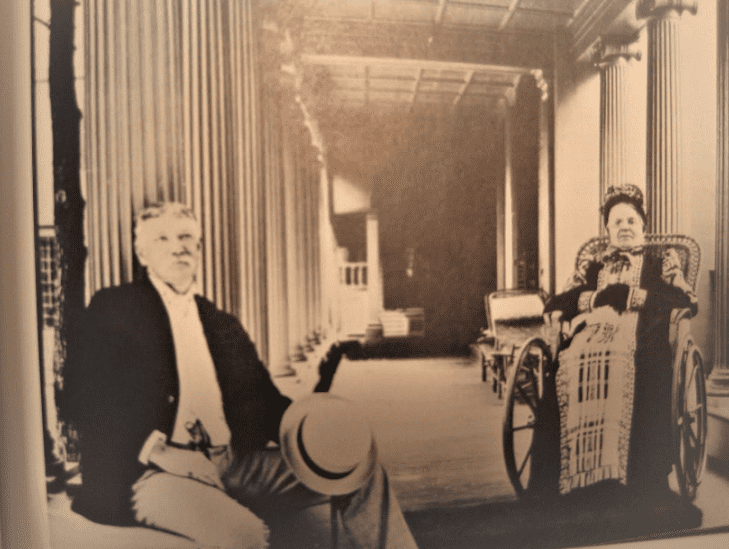
Timothy Nolan Hopkins, the adopted son of America’s richest widow, was the major player in contesting the will – but 21 claimants from the family line joined forces with him. The family members were first and second cousins. They descended from Nathaniel Hebbard and Abigail Sherwood of Connecticut. Abigail was the sister of Mary’s father William Sherwood.
The suit to break Mary’s will was brought before Judge Rollin E. Harmon in Salem, Massachusetts, in the Essex County Court house on 22 September 1891.
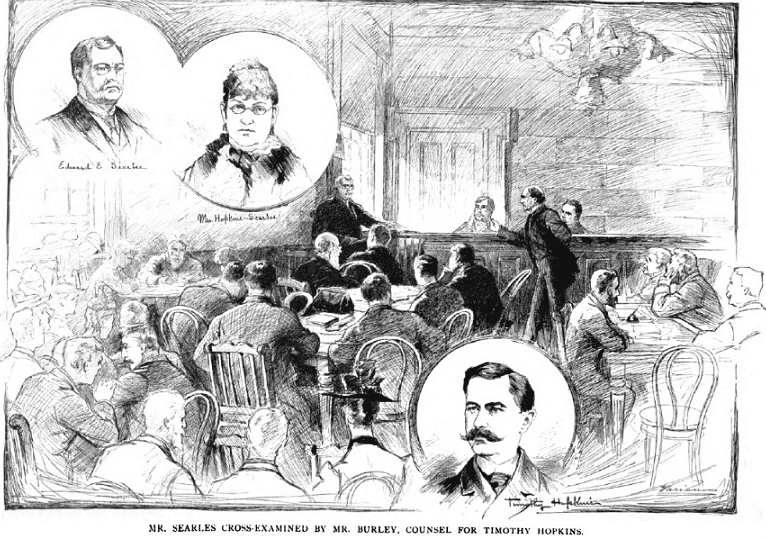
According to newspaper reports, Timothy’s legal team would take on the burden of the fight and the Hebbard’s would not meddle. However, the Hebbard clan chatted up the scandal in interviews with reporters.
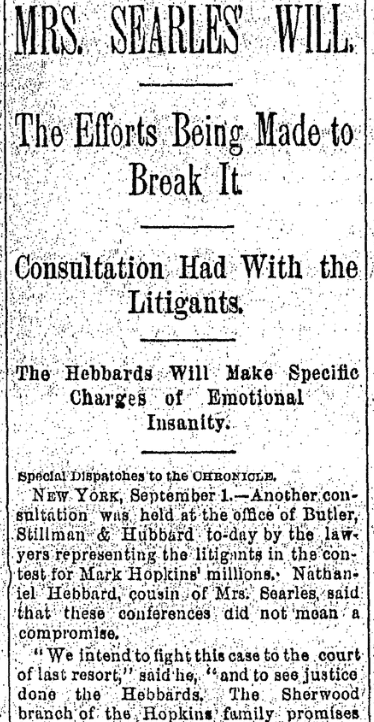
These are their stories, found in GenealogyBank’s Historical Newspaper Archives.
The leader for the 21 contestants was also named Nathaniel Hebbard, a cousin to Mary. He lived on Madison Ave in New York and had a small cottage in Bridgeport, Connecticut. Nathaniel told reporters Mary had assured him all her kin would be provided for: “You will be remembered handsomely in my will; you are not so numerous that I cannot afford to make you large bequests.”
Nathaniel stated that he and his family had numerous letters confirming Mary’s intention to take care of them, and that before Mary married Edward she visited many of her cousins on the East Coast. She gave them money, gifts, and jewels. Mary was always kind and generous but “he [Searles] wrecked her mind and drove her insane and used undue influence.” (The family letters are housed in Stanford University Archives’ Timothy Hopkins Papers.)
The family believed part of Edward’s hold over Mary came from the spirit word of occultism. In addition, Edward circulated false stories about Mary’s family. He called her relations “beggars” and “squatters” and asserted they were only looking for a handout. Edward had the ear of Mary’s estate manager, and testimonies provided to the court revealed that many financial decisions were made at the seance table.
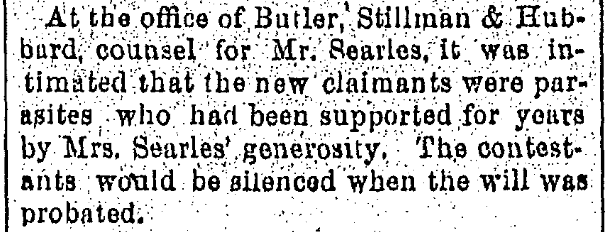
Nathaniel said Mary had promised her cousin William Hebbard, a silversmith, that she would purchase him an apartment house generating income that he could retire on. When William picked out a place that would bring in $1,100 a month income, he traveled to “Kellogg Terrace” – Mary’s estate in Great Barrington, Massachusetts – to secure final arrangements. Nathaniel said that Mary called William a beggar and “abused him shockingly.” She ejected him from the premises. He died shortly after of “a broken heart.”
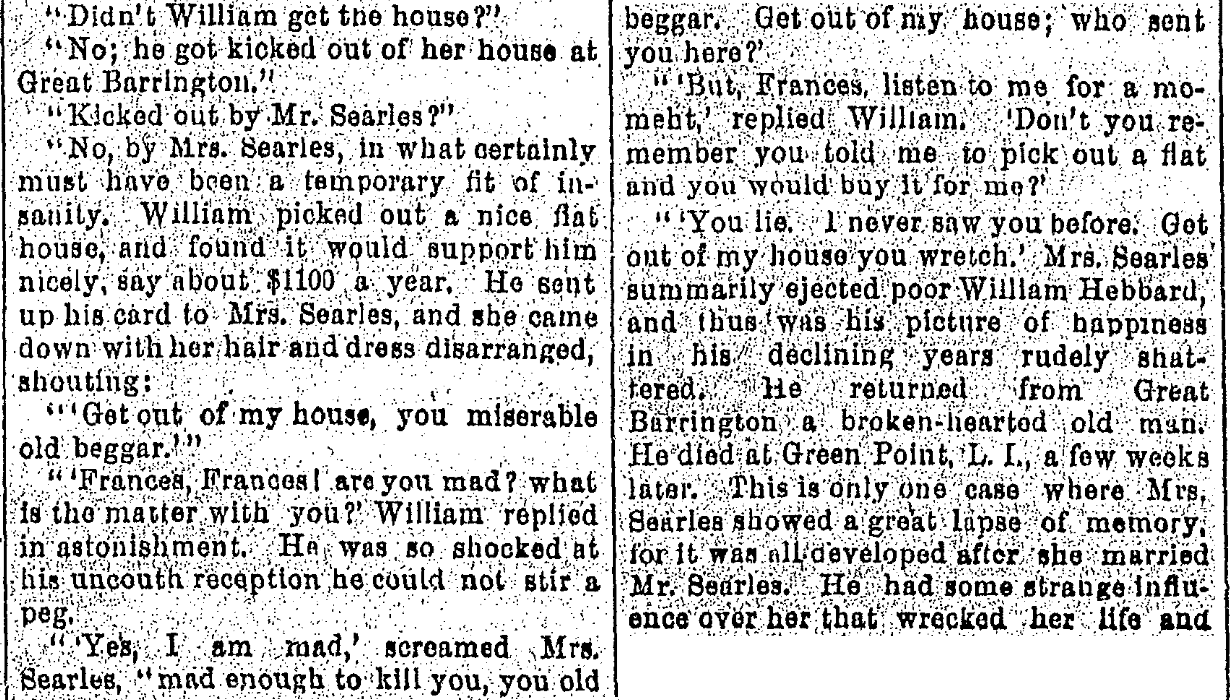
In Davenport, New York, two cousins – Harriet Hebbard and Jane Ann Hebbard Smith – received $300 a year from Mary. When the press visited the aged lasses at their home, they told reporters they were not talking about the case because they were “too smart for them.” They did spill on their intimate connection with Mary, however. It was Mrs. Smith who hosted Mary’s wedding in New York when she married her first husband, Mark Hopkins. They had gone to school in Great Barrington together.
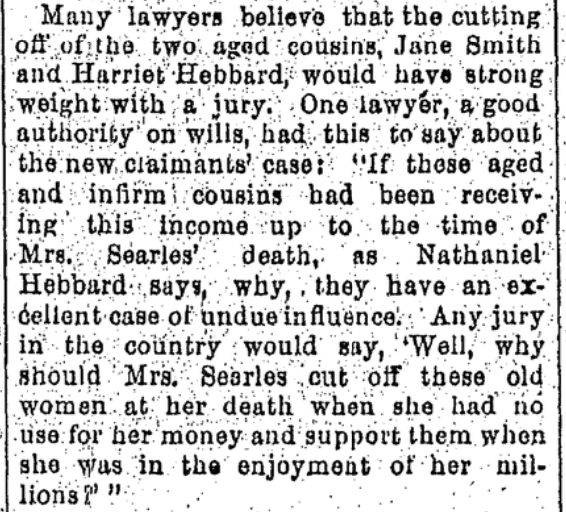
Nathaniel told reporters he only made $11 a week and could not take on the annuity Mary had promised to the aged and invalid cousins. He wanted to see justice being done and would “fight with his whole heart.”
The two old women didn’t want to get dragged into the probate hearing, but feared they eventually would.
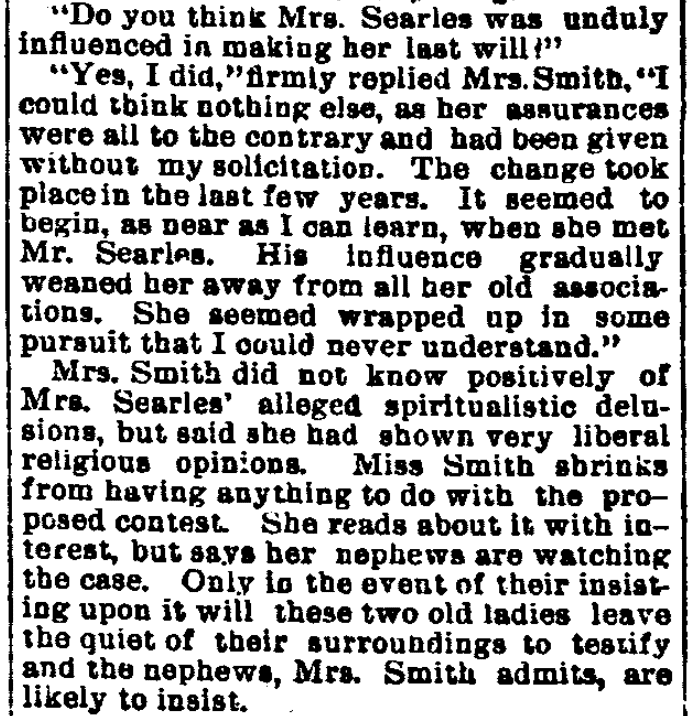
The one thing the Hebbard kin agreed on was how shocked they all were when they discovered that Mary had cut her adopted son Timothy out of her will.
This is not over yet and more will come.
Explore over 330 years of newspapers and historical records in GenealogyBank. Discover your family story! Start a 7-Day Free Trial
Additional Sources:
- Hopkins, Timothy. “The Kelloggs in the Old World and the New.”
- Payne-Joyce. Genealogy Massachusetts, Society of Genealogists.
Genealogy of the Claimants in the Case:
- The claimants were connected to Mary Francis Sherwood Hopkins Searles through her father William Sherwood of Jehial Sherwood (1738/39-1807) and Sarah Squire (1747-1793), daughter of Daniel Squire (1722-1775) and Abigail Osborn (1729-1815). The Sherwood family were in Connecticut–Jehial (Benjamin, Thomas).
- Lyman B. Sherwood (1781-1877), son of Jehial Sherwood (1738/39-1807) and Sarah Squire (1747-1793), married Betsey Minor (1786-1856), daughter of Jonathan Minor (1754-1835) and Sarah “Sally” Frost (1763-1837). Children: Lyman B. Sherwood (1824-1901), married Sarah Moorehouse Banks (1823-1895); Delia Sherwood (1817-1904).
- Abigail Sherwood (1777-1860), daughter of Jehial Sherwood (1738/39-1807) and Sarah Squire (1747-1793), married Nathaniel Hebbard (1778-1825), son of Elisha Hibbard (1746-1825); grandson of Nathaniel Hibbard (1709-1790); great grandson of Nathaniel Hibbard (1680-1725) of Massachusetts and Sarah Crane (1680-1721), daughter of Lt. Jonathan Crane (1658-1735) and Deborah Griswold (1661-1704). “Genealogy of the Hibbard family who are descendants of Robert Hibbard of Salem, Massachusetts.” Note: *The spelling of the name is Hibbard/Hebbard. Abigail Sherwood was sister to William Sherwood, father of Mary Frances Sherwood, wife of Mark Hopkins and Edward Francis Searles, and adopted mother to Timothy Hopkins.
- Elisha Hebbard (1802-1872), son of Nathaniel Hebbard (1778-1825) and Abigail Sherwood (1777-1860), married Olive Ferry (1802-1875).
Children of Elisha and Olive:
- Jane Hebbard (1831-1918), married Captain George Thomas Hollingworth (1831-1911), son of Thomas Hollingworth, buried in Forest Hill cemetery in Utica, Oneida County, New York. Daughter Ida L. Hollingworth married W. H. Fitchard. Ida was a member of the Daughters of the American Revolution #74830 1924.
- Nathaniel J. Hebbard (1833-1910), married Elizabeth Mercer (1840-1915). Adopted daughter Laura Isabel Hebbard (1882-1960), married Archibald Haywood.
- Alonzo Hebbard (1827-1887), married Margaret Ann Chitry. Son: Alonzo Hebbard (1856-1930).
- Josephine Hebbard (1836-1913), married Harry Davis.
- Olive Amelia Hebbard (1842-1912), married George W. Wheeler (1842-1920).
- Horace Hebbard (1806-1883), son of Nathaniel Hebbard (1778-1825) and Abigail Sherwood (1777-1860), married Samantha Hoyt (1805-1875), daughter of Joseph Bouton Hoyt (1775-1844) and Thankful Benedict (1781-1844), and married 2nd her sister Thankful Hoyt; no issue.
Children of Horace and Samantha:
- Rodney Lewis Hebbard (1830-1906), married Sarah Agnus Hanford (1834-1875), daughter of Ebenezer Hanford (1789-1875) and Hulda Follett (1794-1861), and 2nd Agnes M. Montgomery (1839-1907).
- Marie Elma Hebbard (1836-1920), married Phineas Franklin Bresee (1838-1915), son of Phineas Philips Bresee (1812-1895) and Susan Brown (1812-1902).
- Nathaniel Hebbard (1817-1851), son of Nathaniel Hebbard (1778-1825) and Abigail Sherwood (1777-1860), married Mary Ann Williams (1817-1844), daughter of Isaac Williams (1775-1843).
- Harriet Hebbard (1809-1894), daughter of Nathaniel Hebbard (1778-1825) and Abigail Sherwood (1777-1860), no marriage.
- Jane Ann Hebbard (1811-1897), daughter of Nathaniel Hebbard (1778-1825) and Abigail Sherwood (1777-1860), married William Smith, a jeweler.
- Mark Hopkins (1813-1878), son of Mark Hopkins (1779-1828) and Anastasia Luken Kellogg (1780-1837), married his first cousin Mary Francis Sherwood (1818-1891), daughter of William Sherwood (1786-1871) and Lydia Ann Kellogg (1793-1865), daughter of Ezra Kellogg (1758-1833) and Mary Whiting (1758-1837).
- Mary married 2nd Edward Francis Searles (1841-1920), son of Jesse Gould Searles (1805-1844) and Sarah Littlefield (1809-1896), grandson of James Searles (1773-1857) and Abigail “Abi’ Duren (1771-1868). Edward and his wife Mary Francis Sherwood Hopkins Searles (1818-1891) are buried at the Presentation of Mary Cemetery, also known as Our Lady of Sacred Heart Chapel, Searles Chapel.
- Mary’s adopted son, Timothy Nolan Hopkins (1859-1936), was born to Irish immigrants Patrick Nolan (1829-1862) and Catherine Fallon (1834-1903) in Augusta, Maine. (Harold Clarke Durrell, “Memoirs of Deceased Members of the New England Historic Genealogical Society” NEHG Register April 1936.) He married the niece of Mary and Mark Hopkins, Mary Kellogg Crittenden (1862-1941), daughter of Hiram Crittenden (1814-1883) and Lydia Sherwood (1829-1877). They had one daughter, Lydia Kellogg Hopkins (1887-1965).
- Timothy Hopkins was a member of the New England Historic Genealogical Society and produced genealogies; one was a three-volume series, “The Kelloggs in the Old World and the New” and “John Hopkins and Some of His Descendants.” His wife Mary was a member of the Daughters of the American Revolution, the Mayflower Society, and the Colonial Dames. p. 30, “Order of the Descendants of Colonial Governors Prior to 1750: Roll of Members in State of California.”
- Russell Wilson, attorney for Timothy, met with Frank Rogers of Bridgeport, Connecticut, who represented the Shrewood/Hebbard clan. However, two Sherwood siblings, Lyman and Delia, filed on their own. Lyman Sherwood was interviewed by the Boston Globe in August 1891 and stated he intended to stay out of it, but on September 12 he and his sister Delia were added to the list and represented by Frederic Stone Barnum in Salem, Massachusetts.
Other Articles in This Series:
- Fake Wills & Forged Bibles Lay Claim to Mark Hopkins’ Huge Estate
- The Gilded Age Palace: What Mark Hopkins Bankrolled
- Mad Scramble to Claim Mark Hopkins’ Riches: A ‘New Gold Rush’
- Diary of Young Girl Recalls Gilded Age
- Pedigree, Pearls, and Pooches: The Hopkins Saga Continues
- The Mysterious Death of Heiress Lydia Kellogg Hopkins, Part I
- The Mysterious Death of Heiress Lydia Kellogg Hopkins, Part II
- R. Moss’ Hoax: A Scam for the Hopkins Fortune
- More Legal Battles over the Mark Hopkins Railroad Fortune
- Scams to Get the Hopkins Fortune: Seances, Table Tipping, and Slate Writing
- More Hopkins Saga: Minister’s Wife Battles Edward Searles

Another fabulous article by Melissa Berry.
Thanks Elizabeth!
I agree with Elizabeth Needham — a great article.
Thanks Dorothy!
I think the picture of Searles with the woman in the wheelchair is his mother, Sarah Littlefield Searles, not Mary Hopkins Searles. I saw the same picture on methuenhistory.org & she is captioned there as his mother.
Hi James,
Thanks for commenting. I know there was a photo online with that label, but there is a family album that was purchased which has similar images and labeled Mary. If you look at the later images of Mary it is very plausible. I have not found many photos of the Searles family other than his brother and wife.